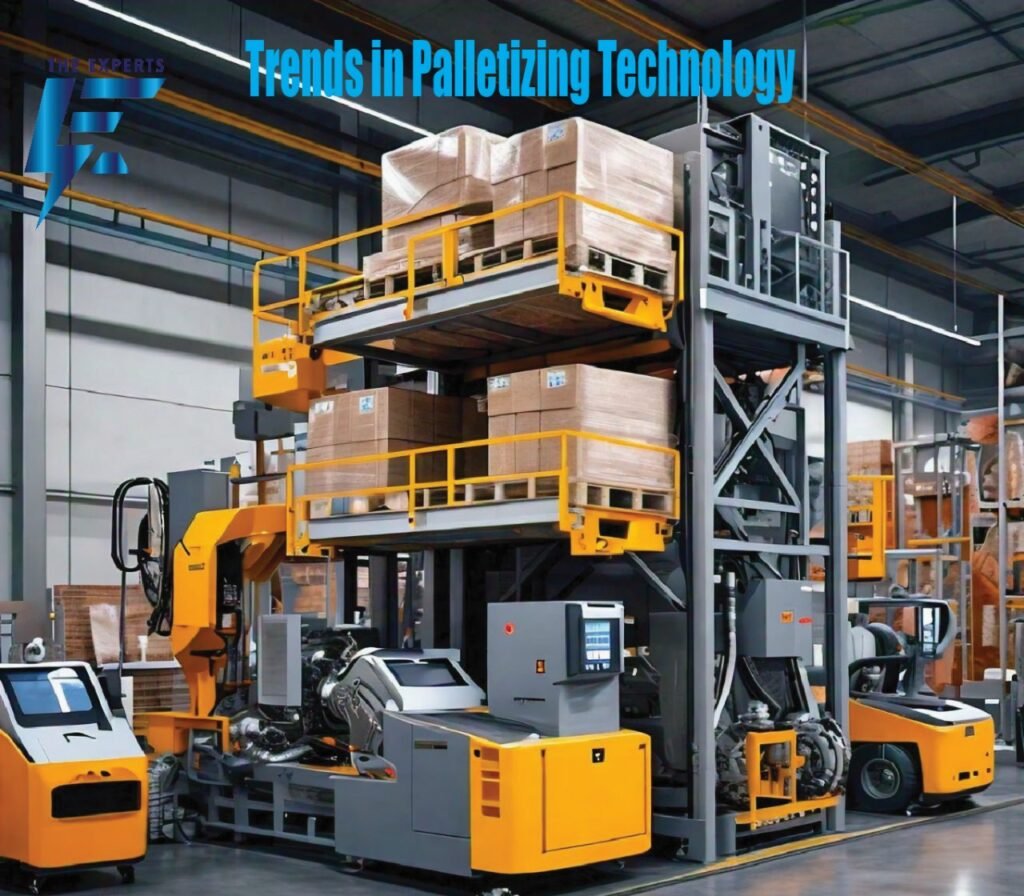The technology of palletizing is of immense importance when it comes to logistics and management of a supply chain. With the change of industries, the need for improved, flexible and environmentally friendly approaches has caused rapid development in palletizing technologies. In this article, we explore the major trends in palletizing technology affecting this sector today such as automation and smart technologies initiatives for sustainability new norms in pallets safety improvements merits and demerits and a glance into the future.
The Rise of Automation in Palletizing
Robotic Palletizers
The advent of robotic palletizers has become a prominent feature in the contemporary technology for palletizing. Manual palletizing which is a more common technique involves more of human effort as opposed to robotic system which replaces the human input of piling up of products on pallets.
Advantages Over Traditional Methods
- Increased Efficiency: With robotic palletizers, there is no down time, resulting in increased output. For instance, a robotic palletizer can place as many as 1,200 cases on a pallet in one hour while manual systems can hardly do 300 in an hour.
- Precision and Accuracy: Self-controlling robotic palletizers possess sophisticated vision systems which allow them to recognize and work effectively with different shapes and sizes of products, ensuring accurate alignment with minimal risk of product damage.
- Flexibility: These kinds of systems can be easily modified to cater to a different product/packaging design thus making them very flexible to market changes.
Case Studies of Successful Implementations
- Coca-Cola: Thanks to the introduction of robotic palletisers, Coca-Cola has improved its production processes by cutting down on the Labor cost by about thirty percent and increasing the output by twenty percent.
- Unilever: The corporation adopted robot systems for its palletizing operations and achieved 15% savings in operation costs and 25% increase in operational efficiency.
Integration with AI and Machine Learning
AI and machine learning are causing a revolution in the palletizing industry. These technologies allow systems to use data for learning and get better as time goes on.
Predictive Maintenance
AI-powered predictive maintenance helps spot possible problems before they cause downtime. For example, systems can look at performance data to predict when equipment needs upkeep. This cuts down on surprise shutdowns and makes machines last longer.
Enhanced Operational Efficiency
AI-powered predictive maintenance helps spot possible problems before they cause downtime. For example, systems can look at performance data to predict when equipment needs upkeep. This cuts down on surprise shutdowns and makes machines last longer.
Smart Palletizing Systems
IoT Integration
The phenomenon of the Internet of Things (IoT) leads the smart palletizing transformation. Such IOT devices can gather and transmit data contemporaneously which helps in providing valuable data about the operations.
Real-Time Data Tracking and Analysis
IoT sensor nodes are capable of measuring and monitoring key parameters such as temperature, humidity, and even load-safety conditions in transit. This information is very beneficial as it helps in making sure that the products are always kept within the appropriate levels especially in delicate industries such as food and drug.
Improved Inventory Management
Smart palletizing systems make it easier to manage stock levels, offering a comprehensive view of the available stock and its movement. This functionality gives businesses the opportunity to enhance their supply chain management processes hence minimizing the costs associated with carrying inventory as well as improving cash flows.
Adaptive Palletizing Solutions
Adaptive palletizing systems manage the inflation of flexibility and efficiency for different types of products.
Flexibility to Handle Various Products
Contemporary palletizing setups can be adapted in a short time relative to the alterations in the dimensions, mass, and wrapping of products, which lessens the rising idling times during product alterations.
Customizable Pallet Patterns
Such systems enable the design of specific pallet patterns that maximize space and minimizes the occurrence of damage during freight transport. This is useful in particular for businesses that transport products with different sizes.
Sustainability Trends
Eco-Friendly Materials and Practices
One of the more overlooked factors is the growing focus on Sustainability in the trends in palletizing technology as well. Many companies are opting for green materials and practices to optimize their waste.
Use of Recyclable and Biodegradable Pallets
A number of industries are turning to the use of recycled or biodegradable pallets, such as pallets made out of compressed wood fibre or those made out of bioplastics. Such alternatives considerably reduce the environmental impact that was associated with the use of wooden pallets.
Energy-Efficient Machines
Modern palletizing machines are energy efficient. For example, electric palletizers use much less energy than their pneumatic versions, thus helping the companies achieve their green goals.
Reducing Waste and Improving Efficiency
The sustainable approaches directed at the palletizing technology are also targeted at waste reduction and efficiency enhancement.
Strategies for Minimizing Over-Packing
In order to avoid excessive packing, organizations are putting into practice refined algorithms that optimize the loading of pallets. This conserves on material thus cuts transportation costs as space inside the truck or container is fully utilized.
Impact on Carbon Footprint
Improving operational efficiencies and reducing any form of waste enables businesses to dramatically cut down on their carbon footprints. Research indicates that organizations implementing green approaches to their logistics operations can reduce emissions by as much as 30%.
Innovations in Pallet Design
Development of Lightweight and Strong Pallets
Progress in the field of materials science has enabled the production of heavy-duty pallets but still lightweight and easier to manage and carry around.
Benefits for Shipping and Handling
The utilization of light pallets not only saves on freight costs but also increases the safety of the workers. For instance, the weight of pallets is significantly reduced and therefore reduces the strain on workers while performing manual handling and this can help to reduce the incidents of workplace injuries.
Custom Pallet Sizes for Specific Industries
Various sectors commonly have their own specific requirements when it comes to pallets. One of the current practices of designing commercial pallets is the widening of the acceptable dimensions, which helps companies a great deal in improving their logistical processes.
Sector-Specific Solutions
- Food and Beverage: Stability of the load and its weight distribution must be taken into consideration when designing pallets designed for the transportation of bottles or cans.
- Automotive: The automotive component custom pallets have to support greater loads and ensure safe transport, in order to prevent any damages.
Enhancing Load Stability
Pallets made to order help enhance the stability of the loads, thus minimizing the chances of any losses during transportation. For example, customer pallets entry may consider certain shapes of loads may be designed in way that will help maintain the load’s integrity.
Enhanced Safety Features
Ergonomic Designs to Reduce Worker Strain
With the rise of automation, more focus is placed on the ergonomic aspects of palletizing technologies so as to reduce the strain on the workers. Ergonomic designs help to mitigate the chances of injuries that are caused by manual handling.
Safety Protocols and Technology Integration
Sensors and Automation to Prevent Accidents
Palletizing systems these days come with obstacle detection and accident-avoidance systems that greatly enhance their efficiency and speed especially in the congested and busy premises of a warehouse. For example, safety cages and the emergency stopping systems will go a long way in curbing the dangers present in the work environment.
Training and Compliance Measures
To keep a workplace safe, it is important to undergo training sessions regularly and comply with all safety measures without question. Also, to avoid losses associated with the introduction of new technology, it is upon the companies to train their staff on how to use the technology, and the safety requirements that it entails.
Challenges and Considerations
Initial Investment and ROI Analysis
Although the advantages offered by new palletizing systems are obvious, the businesses have to take into consideration the capital expense involved. Especially, it is important to conduct a return on investment analysis to justify such costs.
Cost-Benefit Analysis
An all-encompassing cost-benefit assessment must consider prospective gains realizing efficiency improvements, cost of Labor, decreased error rates, and so on, with particular attention to the initial capital outlays of the equipment and the implementation of the systems.
Adaptation to Changing Industry Standards
Nay, the logistic business is progressing and therefore, businessmen have to be ready to change existing practices and methodologies in line with the new norms and regulations regarding palletizing. this flexibility is necessary in order to ensure that there is compliance and competitiveness in the market.
Balancing Technology with Workforce Needs
With the rise of automation, businesses are bound to find a middle ground between technology and the human workforce. In order to take on the future challenges presented by automation, it will be important to develop and retrain workers in the near term.
Future Outlook
Predictions for the Next Decade in Palletizing Technology
In the horizon of palletizing toometric systems, beyond automation and deployment of intelligent technologies it is foreshadowed that there will be increasing levels of integration in all processes. As the sophistication and sophistication of artificial intelligence and machine learning grows, so, too, shall the efficiency and adaptability of palletizing systems to market transformations.
Potential Disruptions and Opportunities in the Market
Revolutionary technologies on the rise including but not limited to blockchain technology can make the existing supply chain practices obsolete. With blockchain implementations creating the possibility of providing transparent and unequivocal records, the traceability factor and answering to every action on the pallet is heightened to the next level.
The Role of Ongoing Research and Development
Investing in R&D will be critical to advancing palletizing technology innovation. All firms will be able to react to market dynamics quickly and make use of new prospects, as long as they advocate R&D facilities.
Conclusion
Emerging trends in palletizing technology is expected to change the logistics and supply chain management as we know it today. They range from automation and smart systems to sustainability and futuristic designs of pallets, businesses cannot afford to ignore these trends. This because such tendencies make it possible to raise effectiveness, lower expenses and safeguard the planet.
FAQ
1. What is palletizing technology?
The technology of palletizing is referred to as the methods and systems of stacking and arranging products on pallets for the purpose of storage and transportation. It encompasses both manual and automatic processes.
2. How do robotic palletizers work?
Robotic palletizers are automated robots with vision systems installed that help in placing products accurately on pallets. They can work round the clock therefore increasing output and cutting down on labor costs.
3. What are the benefits of using IoT in palletizing?
The benefits of integrating the Internet of Things into a business environment make it possible to carry out product tracking in real time, improve management of inventories, analyze data for better operational functioning, which in turn reduces costs and enhances the service to customers.
4. How can palletizing technology contribute to sustainability?
Contemporary palletizing machines make use of eco-friendly materials, practice the concepts of green packing techniques by not wasting any excess space and use less energy, which corresponds with the environmental sustainability trend and mitigation of the negative effects posed by the environment.
5. What are some challenges businesses face with new palletizing technologies?
The issues of which we speak encompass, amongst others, the first capital outlay, tendency to redesign internal processes to fit the existing market, and the issue of rising levels of automation versus need for manual input.
6. What is the future of palletizing technology?
Most likely, in the coming years, there will be more automation, improvements in artificial intelligence, further development of materials, and design that will contribute to the more effective and eco-friendly management of logistics and supply chain operations.
Read more about Technology Trends on The Expert Tech.

